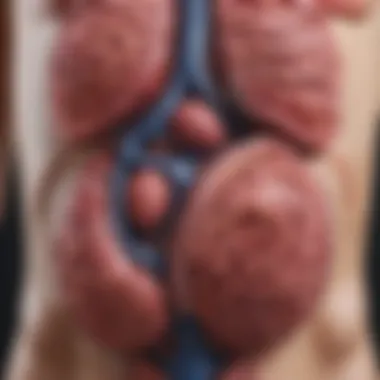The Pancreas: Essential Functions in Health and Disease


Intro
The pancreas is often overlooked in discussions about human health, overshadowed by more prominent organs like the heart or liver. However, this organ plays a pivotal role that cannot be underestimated. Located behind the stomach, the pancreas is a dual-function organ, meaning it serves both endocrine and exocrine functions. In simpler terms, it deals with hormones and digestion, creating a complex interplay that is essential for maintaining our body's equilibrium.
Understanding the pancreas's multifaceted roles provides critical insight into how it influences overall health. This article will explore its anatomy, the hormonal balance it maintains, and the implications of various pancreatic disorders. By diving into the depths of this organ, readers can gain a greater appreciation for its importance and the impacts it has on metabolic processes and digestion.
As we journey through the layers of this topic, we will also discuss future directions in research that could unveil new therapeutic options, improving treatment strategies for those with pancreatic diseases.
In essence, the pancreas is not just a mere organ; it is a powerhouse that significantly impacts how our bodies utilize nutrients and manage blood sugar levels effectively.
Prelims to the Pancreas
The pancreas, often likened to a watchful guardian of our digestive health, holds pivotal significance in managing both digestion and metabolism. This organ, although small in size, plays a critical role in various essential processes that sustain our body's functions. Understanding its complexities goes beyond mere anatomical knowledge; it encompasses the how and why of its operations that directly impacts our well-being.
The pancreas can be viewed as a dual-function powerhouse. It is both an exocrine and an endocrine organ, producing enzymes crucial for digestion while also regulating blood sugar levels through hormone secretion. This dual role underscores its importance not just in digesting food but in maintaining energy balance, showcasing the integral relationship between nutrition and metabolic health.
Furthermore, the pancreas is often at the center of serious health conditions, such as diabetes, pancreatitis, and cancer. The implications of these diseases on overall health make it clear that knowledge about this organ is paramount for anyone invested in health sciences.
In this discussion, we aim to explore the anatomical structure, physiological functions, and the common disorders affecting the pancreas. It will help highlight the importance of ongoing research and innovations in treatment as we continue to unravel the myriad ways this organ influences human health.
"The pancreas is like a silent partner in the entire digesting process, quietly working behind the scenes to keep everything running smoothly."
With that in mind, let's dive deeper into an anatomical overview that illustrates the distinct characteristics of this fascinating organ.
Pancreatic Anatomy
Understanding pancreatic anatomy offers valuable insights into how this essential organ functions. The pancreas is not just a mere player in the digestive system; it acts as a bridge between digestion and metabolism, impacting how our bodies manage energy. Its structure is tailored to perform both exocrine and endocrine functions, which are integral for sustaining health.
Location and Size
The pancreas is located in the abdominal cavity, nestled behind the stomach and near the duodenum. It has a shape reminiscent of a tadpole, with three main parts: the head, body, and tail. On average, it measures around 6 to 8 inches long. Its position is strategic, allowing it to release digestive juices directly into the small intestine. This anatomical placement is essential; it enables the pancreas to efficiently engage with both food and hormones.
Structural Composition
The pancreas is a composite organ, containing both exocrine and endocrine tissues. Each type serves different, yet complementary, roles crucial for human health.
Exocrine Tissue
Exocrine tissue makes up about 95% of the pancreas and is primarily responsible for producing digestive enzymes. These enzymes, such as amylase and lipase, help break down carbohydrates and fats. The key characteristic of this tissue is its zymogen granules, which store inactive enzyme precursors, preventing self-digestion.
Unique Feature: The pancreas's ability to adapt enzyme production based on dietary intake showcases its responsiveness, enhancing digestive efficiency. This adaptability is a significant advantage when considering the varied diets humans encompass. Without this robust exocrine function, digestion would be far less effective, leading to nutrient malabsorption and subsequent health issues.
Endocrine Tissue
In contrast, the endocrine tissue is responsible for hormone production, including insulin and glucagon, both vital for glucose metabolism. This portion of the pancreas contains clusters of cells called islets of Langerhans. The key feature here is the quick response to blood glucose levels; as these levels fluctuate, the pancreas adjusts hormonal output accordingly.
Unique Feature: The fine-tuning of hormone secretion is crucial for maintaining homeostasis. A defect in this system can lead to disorder, such as diabetes, illustrating the importance of this tissue. The interplay between the exocrine and endocrine systems emphasizes the pancreas's multifaceted nature in preserving health and addressing metabolic demands.
"The pancreas, often overshadowed by the more prominent organs, holds its own in the complexity of the human body, making it a silent but significant contributor to overall well-being."
In summary, the anatomical structure of the pancreas is not just of academic interest; it is a pivotal aspect that influences digestion and metabolism significantly. Understanding this anatomy can also shed light on common disorders, paving the way for better prevention and management strategies.
Physiology of the Pancreas
The pancreas plays a pivotal role in the intricate mechanisms of digestion and metabolism. It isn’t just a mix of hormones and digestive juices; it’s a finely tuned machine that keeps bodily functions in balance. The physiology of the pancreas emphasizes how this organ operates in symbiotic relationships with the digestive system and the endocrine system, making it essential in maintaining homeostasis. Understanding these physiological aspects reveals not only how we digest food but also how we regulate our metabolism. This subsection provides a foundation for understanding subsequent topics, such as pancreatic disorders and their treatment options.
Digestive Functions
Enzyme Production


Enzyme production in the pancreas is a cornerstone of digestive health. The organ produces several key enzymes—such as amylase, lipase, and proteases—that break down carbohydrates, fats, and proteins, respectively. These enzymes are secreted in inactive forms to prevent the pancreas from digesting itself, a process aptly termed as proenzymes. As food enters the small intestine, these proenzymes are activated, allowing them to perform their vital roles. This mechanism showcases the pancreas’s unique protective feature.
The real beauty in enzyme production lies in its efficiency; these enzymes ensure that our bodies can extract nutrients from food effectively. Without this process, we would struggle to obtain the energy and building blocks we need from our diets. The pancreas, therefore, becomes a hidden hero, as it quietly goes about its work without much fanfare, keeping our digestive system in check.
Yet, there's a flip side to this essential function. If the pancreas is inflamed, or if it can’t produce sufficient levels of these enzymes, digestion can falter. Symptoms like malnutrition or weight loss may emerge. Thus, while enzyme production is crucial for digestion, its failure can lead to significant health concerns.
Role in Nutrient Absorption
The role of the pancreas in nutrient absorption extends further than just producing enzymes. Once food is broken down, enzymes help nutrients enter the bloodstream from the small intestine. This process of absorption is an essential part of the digestive cascade. The pancreas, by regulating the release of digestive juices, indirectly influences how well these nutrients are absorbed. If the pancreas doesn’t function properly, nutrients can become trapped in undigested food and slip away, doing little to provide necessary energy or sustenance to the body.
The distinctive feature of this function is its collaborative nature. Nutrient absorption doesn’t happen in a vacuum; it involves other organs like the liver and intestines, making the pancreas a vital player in a larger game. Nutrients need to be readily available for energy production, cell repair, and overall health, illustrating the pancreas's significant role in our well-being.
However, changes in the gut environment, such as in conditions like irritable bowel syndrome or chronic pancreatitis, might disrupt this absorption process. Therefore, while the pancreas facilitates nutrient absorption, its health is inseparable from the entire digestive system.
Endocrine Functions
Insulin Regulation
Pancreas is also known for its endocrine functions, namely insulin regulation, which is critical in maintaining blood sugar levels. Insulin is a hormone secreted by beta cells in the pancreas and plays a crucial role in glucose metabolism. When blood sugar rises—after a meal, for instance—the pancreas releases insulin to help cells absorb glucose for energy processing. This mechanism not only curbs excessive sugar in the bloodstream but also ensures your body's immediate energy needs are met.
The interesting aspect of insulin regulation lies in its feedback loop. When blood sugar levels drop, insulin secretion decreases, thus maintaining balance. It’s a smart system that adapts to our dietary intake, adjusting releases based on needs. Insulin's role goes beyond just allowing cells to utilize glucose; it also encourages the liver to store any excess energy.
Yet, problems arise when this delicate system falters. Conditions like insulin resistance or diminished insulin production can lead to diabetes mellitus—highlighting how imperative effective insulin regulation is for overall health.
Glucagon Secretion
Complementing insulin is glucagon, produced by the alpha cells of the pancreas. While insulin focuses on lowering blood glucose levels, glucagon has the opposite effect: it increases blood sugar. This regulation is essential, especially during periods of fasting. Glucagon stimulates the liver to release glucose stored as glycogen, ensuring that the body has a stable energy supply even when food is scarce.
Glucagon’s unique role in the body’s energy management chain underscores its importance. Its secretion is a classic example of homeostasis in action, providing another layer of regulation alongside insulin. Considered a response to low blood sugar levels, glucagon acts as a counterweight to insulin, preventing drastic drops in energy availability.
The downside of glucagon’s function emerges when its regulation fails, potentially contributing to metabolic disorders. A disbalance can throw energy management into turmoil, leading to significant health issues. Glucagon and insulin, in partnership, maintain glucose levels, a critical aspect of metabolic health.
Common Pancreatic Disorders
The pancreas plays a significant role in our overall health and wellness, making the exploration of pancreatic disorders crucial. Understanding conditions like pancreatitis, diabetes mellitus, and pancreatic cancer provides insight into how dysfunctions in this organ can impact metabolism and digestion. The importance of highlighting these disorders lies not just in the awareness of their existence but in understanding their potential consequences and the pressing need for effective management strategies.
Pancreatitis
Acute Pancreatitis
Acute pancreatitis stands out as an urgent medical condition. It often manifests suddenly and can escalate quickly, making early recognition and treatment critical. One of the most notable characteristics is its potential to be life-threatening and lead to serious complications, such as organ failure or systemic inflammation.
What's unique about acute pancreatitis is its common cause, which often involves gallstones or excessive alcohol consumption. Patients may experience severe abdominal pain, proximal nausea, and even vomiting. Recognizing these symptoms can lead to timely medical intervention, significantly improving outcomes. Also, understanding the trigger factors creates awareness among the population about dietary choices and lifestyle.
While the acute phase can be harrowing, it generally offers a hopeful aspect. Most individuals recover fully with proper care, although it can lead to chronic issues in some cases. The presence of this disorder in our discussion is beneficial as it emphasizes the crucial need for education on preventive measures, given its preventable nature when recognized early.
Chronic Pancreatitis
Chronic pancreatitis presents a different narrative. Unlike its acute counterpart, this condition develops gradually over years, often as a result of repeated episodes of acute pancreatitis or long-term alcohol abuse. The key characteristic here is that it can lead to constant pain and progressive loss of pancreatic function.
Patients may experience a progressive decline in their quality of life due to recurring pain and malabsorption issues. A unique feature is its stealthy progression, making it difficult to diagnose until it has advanced significantly. This chronic nature emphasizes the need for chronic condition management and lifestyle changes.
Understanding chronic pancreatitis adds depth to the discussion around pancreatic health by shedding light on the long-term consequences of neglecting pancreatic wellness. People need to know about potential complications, such as diabetes or digestive issues, which can occur as the condition worsens.
Diabetes Mellitus
Type Diabetes
Type 1 diabetes is an autoimmune disorder that demolishes insulin-producing beta cells in the pancreas. This forms a crucial aspect of our discussion around pancreatic disorders. The hallmark of Type 1 is its onset in childhood or young adulthood, though it can appear later.
The uniqueness of Type 1 diabetes lies in its absolute requirement for insulin therapy for survival. Its identification raises awareness about the significance of pancreatic function and how the failure to produce insulin leads to severe metabolic disturbances. Including Type 1 in our narrative emphasizes the importance of early diagnosis and ongoing advancements in insulin therapies to help manage this lifelong condition effectively.


Type Diabetes
Type 2 diabetes, the more common variant, poses another dimension to our discussion. Characterized by insulin resistance and often associated with obesity, this condition emerges gradually, making it sneaky and difficult to detect until complications arise.
The pivotal aspect of Type 2 is its relationship with lifestyle factors. Unlike Type 1, some patients may manage their condition through diet and exercise, highlighting the potential for preventive measures. Its inclusion reflects a widespread health concern, urging discussions on how lifestyle changes can significantly alter one's health trajectory.
Pancreatic Cancer
Pancreatic cancer is often overshadowed by other malignancies but is notably aggressive and challenging to diagnose early. This form of cancer frequently develops without noticeable symptoms until advanced stages, which complicates treatment and worsens prognosis.
What’s unique about pancreatic cancer is its association with several risk factors, including smoking, obesity, and age. Understanding these risk factors raises awareness of proactive measures individuals can take in their daily lives. It underlines the urgency of research advancements aimed at early detection methods, improving survival rates.
Highlighting pancreatic cancer in this context serves to educate audiences on the critical need for ongoing research and the significant impact early diagnosis can have. Given its implications on health, this topic encourages a deeper look into how pancreatic health can influence broader health outcomes.
Diagnostic Approaches
When it comes to understanding the pancreas and its significant role in health, diagnostic approaches play a crucial role in identifying issues and providing clarity on the organ's state. Early detection of pancreatic disorders can lead to better management strategies, making these diagnostic methods indispensable. The wealth of data gathered through these techniques not only aids healthcare professionals but also empowers patients with knowledge about their own health, giving them a stronger voice in their treatment plans.
Imaging Techniques
Imaging techniques are often the first line of assessment when any pancreatic anomaly is suspected. They offer a visual insight into the organ's structure and can reveal conditions that might not be evident through symptomatology alone.
Ultrasound
Ultrasound is one of the most straightforward and widely used imaging modalities for the pancreas. This technique employs high-frequency sound waves to create images of the pancreas and surrounding areas. One key characteristic of ultrasound is its non-invasive nature, which generally makes it a preferred starting point in diagnostics. The unique feature of ultrasound lies in its ability to provide real-time imaging, allowing physicians to assess the pancreas dynamically.
Its advantages include cost-effectiveness and the absence of ionizing radiation, which is particularly important for repeated use in monitoring disease progression. However, it's important to note that ultrasound can sometimes miss small lesions or pancreatic tumors that are not located in the best-suited angles for imaging. Despite its limitations, it remains a trusted choice and often a first step in determining pancreatic health.
CT Scans
CT scans, or computed tomography scans, play a vital role in deep imaging of the pancreas when more detailed views are necessary. Unlike ultrasound, CT scans utilize X-rays to create cross-sectional images of the organ. A key characteristic of CT scans is their high resolution and speed, enabling them to capture fine details in a matter of seconds. This technique can effectively identify inflammation, cysts, or suspicious masses, helping to construct a clearer picture of pancreatic health issues.
A unique advantage of CT scans is the ability to provide comprehensive views on adjacent structures, which is vital when assessing the extent of diseases or planning surgical interventions. Yet, there are some considerations; exposure to radiation is a downside, which is why careful selection for necessity is essential in patient care.
MRIs
Magnetic Resonance Imaging (MRI) is another powerful tool in evaluating the pancreas, particularly useful for soft tissue contrast. Its key characteristic is the use of magnetic fields and radio waves to produce images without radiation, making it a safer choice for frequent evaluations. MRIs are particularly beneficial for capturing detailed images of the soft tissue, which aids in identifying conditions like tumors or pancreatitis.
The unique feature of MRIs is their ability to provide excellent contrast of different types of tissues, allowing for better differentiation between normal pancreatic tissue and pathological changes. However, MRI scans can be more time-consuming and are often costlier than other techniques. Additionally, patients with metal implants may face safety concerns, potentially limiting its accessibility for some individuals.
Blood Tests
Blood tests are another critical diagnostic approach that complements imaging techniques. They provide information about various biomarkers associated with pancreatic health, such as enzyme levels, glucose regulation, and inflammatory markers. Understanding these markers can guide healthcare providers in formulating tailored treatment plans and addressing specific issues related to pancretic function. Blood tests serve as a vital piece of the overall puzzle in understanding the complex functionalities and pathologies associated with the pancreas.
Current Treatments and Management
Managing pancreatic health is essential for overall well-being. The treatments available focus on addressing both symptoms and underlying causes of disorders related to this vital organ. This section delves into the options available, including medications and surgical interventions, emphasizing their significance in improving patients' quality of life and health outcomes.
Medications
Medications play a critical role in managing disorders such as pancreatitis and diabetes. They aim to alleviate symptoms, restore normal functions, and prevent complications. Understanding their use can empower patients in their health journey.
Enzyme Replacements
Enzyme replacements are a major aspect when it comes to treating pancreatic insufficiency. People with conditions that impair the pancreas's ability to produce enzymes, like chronic pancreatitis, often struggle with nutrient absorption.
One key characteristic of enzyme replacements is their ability to help digest food by breaking down starches, fats, and proteins. They essentially stand as a lifeline for those whose pancreas cannot adequately perform these tasks. This treatment is a popular choice due to its efficiency in alleviating symptoms like abdominal pain, gas, and diarrhea.
However, patients must consider the need for lifelong therapy, as stopping the treatment could bring back unpleasant symptoms. The unique feature of these replacements is that they closely mimic natural pancreatic enzymes, but they do not completely replicate all functional aspects. The advantages lie in their effectiveness, while a disadvantage might include a dependence on consistent medication intake.
Insulin Therapies


Insulin therapies are indispensable for managing diabetes, particularly for Type 1 diabetes patients who can’t produce insulin. By supplementing the body with insulin, these therapies regulate blood sugar levels and help prevent complications associated with diabetes. This is particularly crucial, as unregulated blood sugar can lead to severe health issues.
The key characteristic of insulin therapies is their ability to mimic the body's natural insulin production. This treatment is favored because it provides a straightforward method of restoring balance to the body’s metabolism. A unique aspect is the diversity of administration methods, including injections and insulin pumps.
While insulin therapies are effective, they do come with disadvantages. Patients may experience fluctuations in blood sugar if doses aren’t accurately calibrated or if meals are inconsistent. Moreover, there is always the concern regarding the possibility of hypoglycemia, making it essential for patients to closely monitor their blood sugar levels.
Surgical Interventions
When medications are not enough, surgical options may be on the table. These can address structural issues in the pancreas that contribute to a range of disorders. Understanding these interventions can open doors to relief when other treatments fall short.
Whipple Procedure
The Whipple procedure, also known as pancreaticoduodenectomy, is a complex surgery primarily performed to treat pancreatic cancer or chronic pancreatitis. The surgery involves removing the head of the pancreas, the duodenum, part of the bile duct, and sometimes parts of the stomach. Its importance lies in potentially curative effects in cases of localized cancer.
A key characteristic of the Whipple procedure is its invasive nature but proven efficacy in improving survival rates for certain cancers. While benefits are significant, this surgery requires extensive recovery and carries risks such as infection or complications related to digestion and absorption.
The unique feature is its ability to reshape the digestive system, allowing some functionality to survive despite the extent of the disease. However, many patients experience lifestyle changes post-surgery involving dietary adjustments and digestive management.
Pancreatectomy
Pancreatectomy, or partial or total removal of the pancreas, may be necessary for patients with severe pancreatic diseases, including cancer. This surgical intervention is critical when the pancreas is irreparably damaged.
The key characteristic of this procedure is its potential to eliminate painful symptoms associated with pancreatic disorders. It can be a beneficial surgical option for those with localized pancreatic cancer that cannot be treated with other means. However, the procedure comes with significant risks, as losing pancreatic tissue impacts insulin production and digestive functions.
A unique aspect of pancreatectomy is the possibility of developing diabetes due to the loss of insulin-producing cells. Patients may need lifelong insulin therapy and careful dietary management. The advantage here lies in the option to pursue what could be life-saving surgery, balanced against the considerable adjustments needed afterward.
Ultimately, while the pancreatic disorders can impose substantial challenges, the developments in treatment and management can offer meaningful options for patients. They highlight both the complexities of pancreatic health and the advances being made to support individuals battling pancreatic diseases.
Emerging Research and Innovations
As we navigate through an era marked by rapid advancements in medical science, the pancreas has taken center stage in various innovative research initiatives. These emerging fields open up a wealth of possibilities not only for enhancing our understanding of pancreatic functions but also for improving treatments and management strategies for pancreatic disorders. It becomes essential to delve into these areas to grasp the benefits and implications for patient care and overall health.
Gene Therapy Approaches
Gene therapy represents a revolutionary path in tackling pancreatic diseases. By leveraging molecular genetics, researchers aim to rectify the underlying genetic flaws that can lead to conditions like cystic fibrosis, which also affects pancreatic functions. For instance, using techniques such as CRISPR, scientists can potentially edit out defective genes, allowing for an effective restoration of normal pancreatic activities.
- Correcting Mendelian Disorders: Gene therapy aims to deliver healthy copies of a gene to the pancreas, which is especially significant for genetic disorders linked with pancreatic failure. This can drastically change patient outcomes.
- Regenerative Techniques: Investigations into stem cell therapy show promise in fostering the regeneration of pancreatic cells. Recent studies suggest that stem cells can differentiate into insulin-producing cells, offering a potential lifeline for those battling diabetes.
"The promise of gene therapy could bridge the gap between treatment and cure, providing patients with not just relief, but hope for a better quality of life."
- Clinical Trials and Future Prospects: Several ongoing trials are testing the efficacy and safety of these therapies. While still in the early phases, these innovative approaches might soon graduate from experimental to mainstream treatments.
Artificial Intelligence in Diagnosis
The intersection of artificial intelligence (AI) and healthcare has paved the way for smarter diagnostic tools, particularly for pancreatic disorders. By harnessing data analytics and machine learning algorithms, researchers are exploring how AI can transform diagnosis and therapeutic strategies.
- Pattern Recognition: AI can analyze imaging data much faster and more accurately than human radiologists when identifying pancreatic tumors or abnormalities. This capability not only enhances diagnostic precision but also accelerates the time to treatment.
- Predictive Analytics: Machine learning models can predict diabetes onset by evaluating a patient’s existing health data, lifestyle habits, and even genetic information. These tools serve as valuable adjuncts to traditional diagnostic methods.
- Virtual Platforms for Monitoring: The introduction of wearable tech integrates seamlessly with AI, allowing real-time monitoring of glucose levels and other relevant biomarkers. It can alert healthcare providers and patients about critical events requiring immediate attention.
As the landscape of pancreas-related healthcare evolves, both gene therapy and artificial intelligence bring immense potential to transform not just how we treat pancreatic diseases, but also how we view their management in the broader context of human health. The exploration of these fields clarifies an important narrative: innovation is key to advancing our understanding and efficacy in treating pancreatic conditions.
Ending
Understanding the multifaceted role of the pancreas is not just an exercise in academic curiosity; it has real-world implications in health care and disease management. The pancreas, often overlooked, is a powerhouse when it comes to metabolism and digestion. A well-functioning pancreas aids in breaking down essential nutrients and regulating blood sugar levels, both of which are critical for maintaining overall health.
Summary of Key Points
In the article, several critical elements have been covered:
- Anatomical and Physiological Functions: The pancreas plays dual roles in the body as both an exocrine and an endocrine organ, producing enzymes and hormones vital for digestion and metabolic regulation.
- Common Disorders: Several ailments can affect the pancreas, including pancreatitis, diabetes mellitus, and pancreatic cancer. Each of these conditions has unique implications for health that warrant attention and understanding.
- Diagnosis and Treatment: The segment on diagnostic approaches and treatment options highlights the importance of timely medical intervention. Methods such as imaging techniques and blood tests are essential for identifying pancreatic disorders early.
- Emerging Research: Innovative therapies, including gene therapy and AI technologies, pave the way for improved diagnostic and treatment strategies, showcasing the potential for better health outcomes in the future.
In essence, recognizing the intricate functions of the pancreas not only enriches our understanding of human physiology but also underscores the organ's importance in different health challenges we face today.
Future Directions in Pancreatic Research
Looking ahead, pancreatic research is poised for significant advancements that will influence clinical practices:
- Personalized Medicine: With ongoing research into genetic factors influencing pancreatic diseases, tailored treatments may soon become a reality.
- Technological Integrations: The incorporation of artificial intelligence in diagnostic models stands to enhance the accuracy of pancreatic condition identifications, leading to faster and more precise treatments.
- Preventive Strategies: More studies could focus on preventative measures, especially regarding diabetes and obesity-related disorders, improving community health awareness.
"The future of pancreatic health lies in personalized, tech-driven approaches that demand our attention today."







